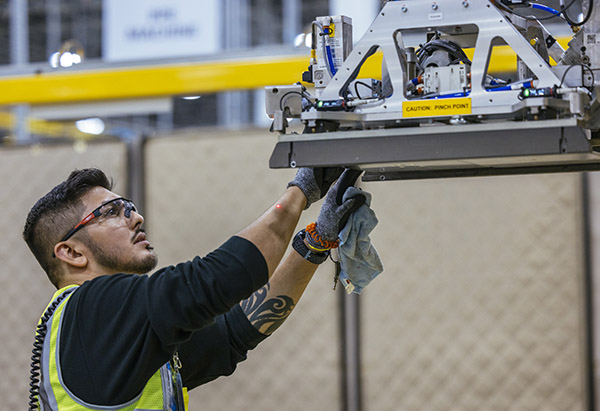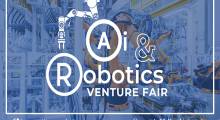National Robotics Week is intended to inspire students to prepare for careeers in robotics and science, technology, engineering, and mathematics, or STEM. One initiative is Amazon.com Inc.'s Mechatronics and Robotics Apprenticeship program, which offers paid training to prepare its employees for electromechanical technician roles.
Despite fears that robots and artificial intelligence will eliminate jobs, U.S. unemployment has remained low over the past several years as automation has increased, and researchers have found that it could increase employment opportunities. While 85 million jobs could be replaced, new technologies could create 97 million jobs, according to The World Economic Forum.
But first, people need education, which is the focus of National Robotics Week. Not only does the Mechatronics and Robotics Apprenticeship (MRA) program help employees join Amazon's Reliability, Maintenance, and Engineering (RME) team, but it is also intended to provide opportunities for those who have historically lacked access to the robotics field, said the e-commerce company.
Kari Carter, senior program manager for the MRA program at Amazon, replied to the following questions from Robotics 24/7:
Amazon offers paid training
How long have Amazon's apprenticeship programs been running?
Carter: Amazon has offered a variety of skills training and apprenticeship programs to employees for many years. The MRA program launched in 2020 and gives employees the opportunity to learn the skills and technical knowledge needed to fulfil a technical maintenance role.
This is just one of our many apprenticeship programs available to employees.
How does the Mechatronics and Robotics Apprenticeship program work?
Carter: The MRA program, which is registered with the U.S. Department of Labor, offers participants 12-weeks of paid learning onsite at one of our five college partners—including paid room and board—followed by 2,000 hours of on-the-job training at Amazon or with one of our hiring partners.
Participants graduate from the program with the industry certifications needed to fulfil technical maintenance roles and, once all requirements are completed, are placed in a job at Amazon or elsewhere. Throughout the program, participants are paid to learn, and [they can] see pay increases after the classroom learning and mentored on-the-job training phases of the program.
The site currently lists “0 open jobs”—how many people are currently enrolled in the MRA program?
Carter: The program continues to run cohorts throughout the year, including throughout 2023. We’re proud to say more than 2,000 apprentices have completed or are currently participating in the program.
Thus far, more than 1,000 have completed the program, graduating from both the classroom learning and on-the-job training, and passing the required industry certifications. We are intentional about how our cohorts are organized and create our learning cohorts for the program based on the open roles available at Amazon or with one of our maintenance partners.
Overall, the program currently maintains a 100% conversion rate into job placement after program completion. Since the first cohort of graduates, the program maintains a retention rate of over 95% for Amazon employees placed through the program—meaning that of everyone placed at Amazon since the program began, 95% are still employed here.
No prior technical experience required
Is prior mechatronics or other engineering expertise necessary?
Carter: One of the exciting aspects of the MRA program is that no previous technical or robotics experience is needed. We ensure that participants receive all of the education, training, and prep that they need to earn the industry certifications for these technical roles, and give them the mentoring and support needed to be successful when they complete the program.
We encourage employees interested in pursuing a career in robotics and mechatronics to apply to the program—our participants come from all backgrounds and have various professional experiences.
Is Amazon looking for internal employees only for this program, or can non-Amazon workers apply?
Carter: The program is one of our skills training programs originally created and offered to current Amazon employees. One of the key differentiators for us through this program is we tap existing employees to participate and then offer them competitive pay while they go through the educational learning and on-the-job training portions of the program, including job placement after completion of program requirements.
Our flexible schedule and approach allows for more diverse participation from people who are from cultural communities typically less represented in maintenance. Across many of our upskilling programs we want to offer our employees compelling opportunities to learn the skills they need to move into in-demand, higher-paying jobs at Amazon or elsewhere, within the growing field of robotics and beyond.
External opportunities with Amazon may be viewed through the jobs website. We also work closely with our college partners and third-party education partners to create additional programs and curriculums that offer opportunities for the general workforce to develop the skills they need to work in robotics.
For example, to meet the needs of neighboring businesses, Dallas College in South Dallas, Texas, recently developed a grant-funded mechatronics training program that provides its students with five mechatronics certifications in mechanical drives, fluid power, programmable logic controllers, electrical motor controls, and robotics. The program is based on the MRA program we created for our apprentices.
Can you specify some of the skills that participants would be learning and using?
Carter: The program teaches technical skills in areas such as industrial electricity, mechanical components, fluid power, and programmable logic controllers. Apprentices receive multiple certifications in each one of these skills as part of their training.
Importantly, beyond the technical skills, we are really proud that we’ve built opportunities to develop soft skills to ensure career success once the participants are placed in their roles. Throughout the program, apprentices receive extensive mentoring, leadership, and networking opportunities to meet with the various teams and employees within RME.
We also have a number of employee affinity and networking groups at Amazon, like Women at RME or the Amazon Mentoring Program, that allow like-minded employees to connect with their peers and leadership, share stories and job opportunities, and more.
Go where the robots are
Can you give examples of Amazon's robots that these technicians are servicing?
Carter: Putting their learnings directly into use, they’re repairing, troubleshooting, and supporting the robots that help keep Amazon processes running smoothly.
This includes mobile robots, like Hercules, that help move inventory across our facilities, and robotic handling systems, like Robin, that help sort packages before they are sent to customers.
Are participants expected to go straight to the Reliability and Maintenance Engineering team, or are there other roles at Amazon they could help fill?
Carter: There are a number of jobs at Amazon that work with robotics, but typically, the MRA program trains participants to fulfill an electromechanical technician role on the RME team.
Where is this training taking place?
Carter: Following completion of the educational coursework through one of our higher-education partners, mentored on-site training takes place at one of our dedicated customer fulfillment sites.
Apprentices are placed in a permanent, full-time job within Amazon’s Reliability and Maintenance Engineering team, or with one of RME’s partners at one of in various facilities across the U.S.
About the Author
Follow Robotics 24/7 on Linkedin
Article topics
Email Sign Up
















